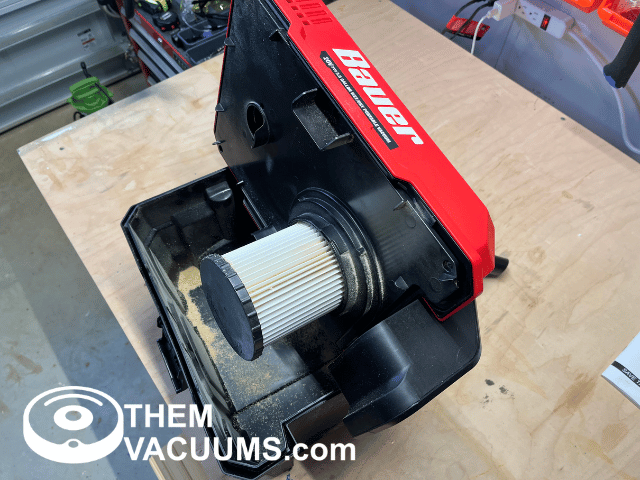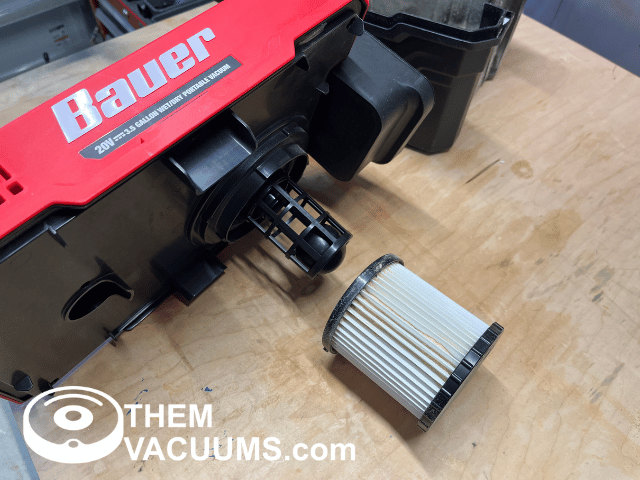Ever wondered how to tackle liquid spills like a pro? Whether it’s water, soda, wine, or even less pleasant substances like urine or feces, a shop vacuum or wet/dry vacuum is your go-to hero.
In this post, we’re diving into the art of using a shop vac to suck up water and other non-flammable liquids. It’s a handy skill to have in your cleaning toolkit, and we’re here to guide you through the process. Stay tuned for a step-by-step guide to handling liquid mishaps like a champ!
What Is A Shop Vacuum?
A shop vac, also known as a wet/dry vacuum or a shop vac, is a type of vacuum cleaner designed to handle heavy-duty cleaning tasks, particularly in workshop or construction settings. It is equipped with a more robust and stronger motor with a larger storage capacity compared to traditional household vacuum cleaners. It’s because of this, that many homeowners are opting to use shop vacuums more than their regular vacuum cleaner.
Shop vacuums are specifically designed to handle a wide range of materials, including both dry debris (such as sawdust, dirt, glass, screws or other small objects) and liquids (such as water, spills, or floods). They are often used in environments where regular vacuums would be inadequate or prone to damage, such as workshops, garages, construction sites, or everyday homes due to kids, pets and other constant messes.
Sucking UP Water With Shop Vac
To clean up water and other non-flammable liquid messes is basically the same as sucking up dry messes, except you need to change or remove the filter.
1. Open Shop Vac, Remove Paper Filter
Open the dust canister of your shop vac to reveal the paper filter. The paper filter is often white, like in the picture above. The filter may not be white, especially if you use it a lot, but it’s almost always the hanging part below the lid.
To remove the paper filter from the shop vac to clean up water requires you to unscrew it, often a slight turn to the left, not a lot of force is needed. Once the filter is unseated, the filter pulls down and off the shop vac.
If your shop vac has a bag, you must also remove it too.
2. Install Foam Filter Or No Filter
When you remove the paper filter you will see a ball float, if you have a foam filter you can place that over the ball float outer housing.
Not every shop vac comes with or can get a foam filter, my batter-powered shop vac pictured above did not come with one, and that is okay. If you’re sucking up liquids, you don’t need a filter, what protects the shop vac is the ball float, so make sure it can move freely.
Trying to clean up liquids with the paper filter still attached will cause it to clog up quickly and stop working. The goal of the paper filter is to keep the dust you’re sucking up from going back into the air, but if you’re sucking up liquids, there is no dust to worry about. The little bit of dust will just stick to the water instead of being blown back out, so it’s not needed for wet messes.
3. Plug Into A GFCI Plug
If you don’t have a battery-powered shop vac, it’s ideal you plug it into a GFCI Plug.
Even though most shop vacuums are double insulated, it’s still a good idea to have the protection in place since you’ll be dealing with water.
4. Clean Up The Water
When the shop vac cleaner is ready, you can start sucking up the water and other wet messes like you would with dry messes.
You’ll know to stop when the shop vac stops sucking the water up and makes a louder and higher pitch sound. This is the ball blocking the suction because the water level is too high, and you need to dump the water.
5. Dump The Water
When done or when the shop vac is full of water, you must turn it off and then unplug it from the wall or battery before you empty it.
Bigger shop vacuums have a drain port at the bottom, but the rest you take the top off and dump the water.
Make sure to let the shop vac dust bin dry out before closing it up after you’re done and before putting the paper filter back on.
Sucking Up Wet & Dry Messes Together
Since a shop vac can be used for dry messes and wet messes, just by changing the filter, it makes many wonder if you can cleaning up both messes at the same time?
One example of a wet and dry mess I run into is cleaning my gutters with my shop vacuum. The leaves and gutter gunk are mostly wet, but you have many dry pieces and dust, so what filter do you use?
When sucking up both wet and dry messes at the same time with a shop vac, you use the foam or no filter, basically treat it like sucking up a wet mess.
Sucking up a wet mess when you still have the paper filter installed will destroy the paper filter and cause the shop vac to not have enough suction. But you need that paper filter for PURELY dry messes, or else the dust will get flung back into the room.
Water & Electricity Don’t Mix!!!
Water and electricity don’t mix, but you can use a shop vac to clean up water.
What you should not do is soak the shop vac with water from a hose, tub or any forceful outside water source.
If you need to clean the shop vac, you can remove the motor portion and clean the bottom with a hose as there is no electronics, but the top motor part must be cleaned carefully with a dry rag with it disconnected from power.
If you left the shop vacuum out in the rain, you’ll need to take the top lid off and the hoses, so it can dry out before trying to use it. Wait at least 24 hours before using and plug it into a GFCI plug.
No Filter
You can use a shop vacuum without a filter, and often it works better without the filter.
The purpose of the filter on a shop vac is to keep the dust that you’re sucking up from going back into the room.
You must take off the filter or use a foam filter when sucking up liquids and other nonflammable wet messes. If the mess is dry and small, you need the paper filter. If the mess is dry but large, like a bolt, the filter is not needed, and you may get more suction power by not using the filter.
No Bag
Just like with the filter, it’s best to use a bag if you’re sucking up dry things. It’s a must to remove the bag if you’re sucking up liquids.
If you take in dry things without a bag, then it will just make a mess in the canister. It can also clog the filter sooner and even leak back out of the vacuum cleaner.
You can make your own basic bag for your shop vac from trash bags.
What You Can Clean Up
I’ve lost count of all the things I’ve sucked up with my shop vac, it’s basically everything that I would not use my normal vacuum cleaner for and was nonflammable.
Here is just a short list of things I’ve sucked up and cleaned up with my shop vac.
Best Shop Vac For Around The Home
Here lately, the best shop vacuums for homeowners I’m finding are battery powered ones.
You can’t beat the ease of use with a shop vac that runs on batteries, especially as I find I’m in a rush because the kids spilled something or glass is everywhere, or you name it. Getting the cord out, the weight of the plugged in ones, and more has me reaching for the cordless shop vac.
I currently use a Bauer Cordless shop vac, but it may not be available for everyone. It requires the Bauer batteries and chargers, but if you’re already in another tool line, they often have a cordless shop vac.
Below is a list of more cordless shop vacuums that I recommend to homeowners.
- Wesco Cordless Shop Vacuum Cleaner. (Amazon Link Ad)
- DEWALT 20V MAX Cordless Wet-Dry Vacuum. (Amazon Link Ad)
- Milwaukee 18-Volt Cordless Wet/Dry Vacuum. (Amazon Link Ad)
Shop Vac For Cleaning Ponds
Using a ShopVac to clean ponds or large bodies of liquids is not recommended. There are several reasons for this, primarily due to the rapid filling and clogging issues caused by the debris present in ponds.
If you attempt to clean that much liquids using a ShopVac, you’ll find yourself emptying it every 20 seconds. I’ve personally tried it, and I can assure you it’s not worth the effort.
Alternatively, you can consider utilizing a submersible pump to redirect the pond liquids into a container if you intend to reuse it. This provides a more efficient solution for managing the liquids and reduces the burden on the ShopVac.
They also make liquid transfer pumps (Amazon Link Ad) made for moving liquids to a different location, and many of them are battery powered.
Or there are stick transfer pumps like in the video above for moving a lot of liquids to somewhere else.

